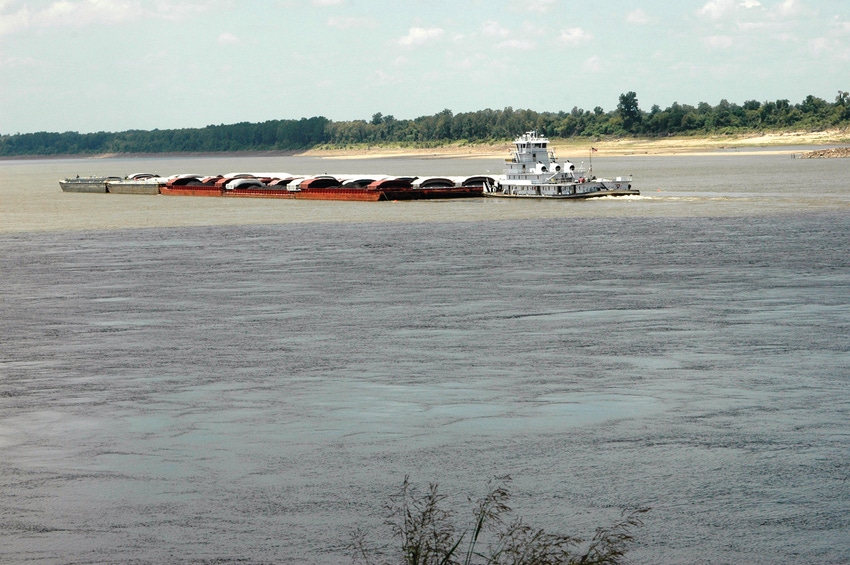
A crumbling U.S. waterways infrastructure is set to receive a major upgrade if the Senate and House pass a compromise bill announced on May 15. After six months of horse trading, a bicameral conference committee agreed on the $8.2 billion Water Resources Reform Development Act (WRRDA) of 2014 that is expected to provide not only waterway improvements but also some 500,000 jobs.
The agriculture sector relies on heavily on the waterway system as more than 60 percent of U.S. grain and other commodity exports are transported along it. Further, 95 percent of farm exports and imports move through U.S. harbors.
”The waterways really are the gateway to how our nation helps feed the world,” said Randy Gordon, president of the National Grain and Feed Association. “And recent rail service disruptions have magnified and reinforced the importance of the United States having an ‘all-of-the-above’ transportation infrastructure policy that focuses on all modes -- truck, rail, barge and vessel.”
Long seven years
It has been “a long seven years since the last water bill, which came to pass (in 2007) after an override of a veto by then-President George W. Bush,” said Debra Colbert, Senior Vice President of the Waterways Council, during a May 16 press call. “After that, to see such a strong bipartisan effort and such strong resounding votes – in the Senate last May and the House last October – it’s very gratifying.
“Our members – barge and towing operators, shippers, port authorities, agriculture, labor, conservation and shipping organizations and waterways advocacy groups – have worked very hard together. We’ll continue to push for a vote (the week of May 19).”
In 2013 -- shortly before the House passed its waterways bill on a 417 to 3 vote -- Colbert spoke with Farm Press about the importance of Congress investing in the system.
On exceeding the system’s design life…
“The problems that we’re facing in the inland industry is that the lock and dam infrastructure are outdated. More than half of the locks and dams have exceeded their 50-year design life. We’re seeing a lot of aging and continual degradation of the system.
“While it’s still reliable for shippers, if we continue funding it at the insufficient levels of the last several years that trend will quickly result in the system’s unreliability and potential catastrophic failure. Some of the issues related to the low-water crisis that threatened shipping in 2012 could be a regular occurrence.
In terms of the 50-year shelf life of the lock and dams, is there actually crumbling of the structures?
“Yes, particularly in the Pittsburgh region where many of the most aged structures are. Construction of many of these was begun in the early 1900s and they are now showing their age. Others were started but not yet completed because the funding isn’t adequate.
“Each year, money is authorized for these projects but isn’t fully appropriated. It’s like building a house over decades instead of just in a year. Instead of the house costing $100,000 and taking 12 months to build, the cost soars as you take longer and longer. That isn’t smart or efficient because the cost of materials continues to rise, there are delays and contractors switch out.”
On waterways and agriculture…
“The cheapest and cost-competitive way for the ag community to get products to export markets is by barge on the waterways. That’s why we have a tremendous agricultural advocacy groups that belong to the Waterways Council. Truck or train just can’t compete.”
Panama canal, commodity groups
Another reason the legislation is likely to pass is the need for U.S. ports to be able to accommodate larger ships that will soon pass through a revamped, deepened Panama Canal.
“We are happy to see the committee come to agreement, issue the report and make concrete steps toward repairing and improving our inland waterways,” said Martin Barbre, National Corn Growers Association president following the conference committee action. “Most of America’s locks and dams were built in the 1920s and 1930s. … Improving this crucial infrastructure will provide U.S. farmers and businesses a reliable transportation channel. By improving our ability to compete in export markets, we fuel our domestic economy as well.”
“This is a huge step forward to ensure the continued success of the soybean supply chain, and leaders in both the House and Senate deserve a great deal of credit for shepherding this bill through a challenging policymaking climate,” said Ray Gaesser, American Soybean Association (ASA) president.
Urging quick passage, the ASA said the legislation would:
Free up significant funding within the Inland Waterways Trust Fund for additional waterways infrastructure projects.
Increase the level of Harbor Maintenance Trust Fund dollars that will be spent on port maintenance and dredging.
Streamline the Army Corps of Engineers’ project review process.
Increase Corps flexibility to maintain navigation during low water events.
Promote the use of alternative financing and public-private partnerships to fund waterways infrastructure.
About the Author(s)
You May Also Like




